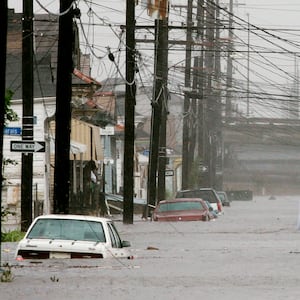LAFAYETTE, Louisiana—New Orleans was plunged into darkness hours after Hurricane Ida made landfall in Louisiana on Sunday, the anniversary of Hurricane Katrina, which killed more than 1,800 people in 2005.
By late evening, local media outlets were reporting that Entergy New Orleans, the power provider for Orleans Parish, had endured “catastrophic” damage and that the city was effectively off the grid. That left well north of 700,000 people across the state without power as the historic Category 4 storm slammed the region.
Late Sunday night, the Ascension Parish Sheriff’s Office reported the storm’s first recorded death. “Shortly after 8:30 p.m. deputies received reports of a citizen possibly injured from a fallen tree at a residence off of Highway 621 in Prairieville,” the sheriff’s office said in a statement posted on Facebook. “Deputies arrived on scene and confirmed that the victim is now deceased.”
The “extremely dangerous” storm, which was downgraded to Category 2 by late Sunday night but still just beginning to make its wrath felt, came as the state and Southeast in general were already buried with COVID-19 cases.
Some hospital systems quickly showed signs of buckling under the strain.
Just before 4 p.m. Sunday, Thibodaux Regional Health System Hospital lost power due to issues with its emergency generator, requiring doctors and nurses on staff to manually force air into the lungs of COVID-19 patients when their ventilators no longer functioned.

According to Mindy Faciane, public information officer with the Louisiana Department of Health, the manual “bagging” of the patients was required while they were moved to areas of the hospital where power was available.
Faciane said she did not know how many patients were affected, nor how long the manual bagging had to be maintained. Calls to the hospital’s media manager for more details were not immediately returned. But state Rep. Jerome Zeringue told NOLA.com that a doc on the scene described the situation as “Katrinaesque.”
The renewed ferocity of the pandemic in the region more broadly served as the grim setting for a uniquely powerful storm. It made landfall as a Category 4 hurricane twice—near Port Fourchon, and near Galliano, according to the National Hurricane Center.
Earlier in the day, the National Weather Service of New Orleans issued a series of warnings, including an ominous message that it “can’t bear to see” the storm on satellite imagery.
“We have hard times ahead, but we will all persevere,” the service tweeted. “Take all messages we, public officials and broadcast media are saying SERIOUSLY. Stay tuned for more frequent updates.”
Warnings about Ida came as Hurricane Nora skimmed Mexico’s Pacific Coast toward the Gulf of California. Ida was expected to cause “catastrophic” damage, leaving the area where it makes landfall “uninhabitable for months.”
Tina Menard, 65, grew up on Grand Isle. Now a Lafayette resident, she and her nephew still own a fishing camp on the island and keep in touch with their friends there.
Early accounts from the area suggested the storm made itself felt there early—and showed no mercy.
“The water is 5 feet deep at the police station,” Menard said. “That’s in the middle of the island.”
Because so many people evacuated early, information from the island was spotty at best.
“I know that the chicken place across the street from the municipal multiplex survived several storms, but its roof blew off this time,” Menard said. “It’s been there since the 1970s. It survived everything, Katrina and all the other storms.”
She also said the people in the area knew the storm was definitely a Category 4, at least, when it rolled over the barrier island.
“The wind gauge at the police station broke at 140 mph,” Menard said.
Louisiana Gov. John Bel Edwards warned late Saturday, “This will be one of the strongest storms to hit Louisiana since at least the 1850s. Preparations need to be complete and you need to be where you intend to ride out the storm by tonight.”

As the storm made landfall, Elaine Leyda was watching her apartment building in the Carrollton River Bend neighborhood of New Orleans.
For the most part, she was finished with her preparations. She had considered evacuating, but said she stayed for the benefit of the tenants in her building. The storm, although still hours away from its peak in the Crescent City on Sunday afternoon, was already making its presence known.
“There’s powerful gusts, and they’re becoming more frequent,” she said. “I have been hearing, the last four hours, very loud ‘BAMs,’ some of which could be transformers. But it’s clear that the storm has begun in earnest.”
At the same time, she is still a New Orleanian, which means she knows how to get by during long outages following storms like Ida, even without a gas stove.
“I had one in my other house, and I miss it at these times,” Leyda said. “But my cuz around the corner has gas, so after the storm I can go there and cook if I need to.”
Around 9 p.m., the National Hurricane Center reported that the eye of the storm was passing west of New Orleans. As the day proceeded, Leyda felt things turning for the worse.
“The gusts are getting very scary now,” she said.

On Sunday night, Cassie Antoine was on the balcony of a friend’s apartment uptown in New Orleans, watching the storm pass by in the dark.
“It’s really kicking out there,” the 29-year-old told The Daily Beast.
Although not a native of New Orleans, Antoine has been in the city long enough to have seen her share of storms. “I lived in Chalmette during Katrina and had water up to my chest,” she said.
Antoine said she got a text message letting her know the power was out citywide. She had relocated to the Uptown area to ride out Hurricane Ida because her neighborhood, specifically around St. Claude Avenue, is prone to flooding, she said.
And now, with no power and no vehicle, she found herself across town from her home with her two cats, Obbie and Collette, for the foreseeable future.
Or at least until she has to return to her job working at a local grocery.
“I basically don’t have any choice,” she said. “I can’t head home on my bike, and I’m not leaving my cats behind. I’ll stay at my friend’s place and wait until they say it’s all good to go back to work.”
Just east of downtown Baton Rouge, Louisiana State University journalism professor Will Mari still had power at his home as of 9 p.m. Sunday night.
“We are somehow still on,” Mari said. “I think it’s because we’re close to Mid City General Hospital.“
Mari had been watching the winds strengthen throughout the day as Hurricane Ida inched northward, beating the Louisiana coast and scouring the metropolitan New Orleans area.
“Several neighbors have compared this to Katrina, and some older folks to Camille, even,” he said. “We all feel for Metairie and Hammond—they’re getting beat up bad.”
The self-professed “weather geek” said he was not planning to sleep Sunday night. Not much, at least.
“I think we’ll get lucky, but it’ll still be a long night,” he said. “I’ll be up through to the morning.”








